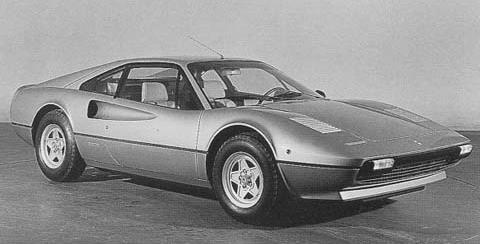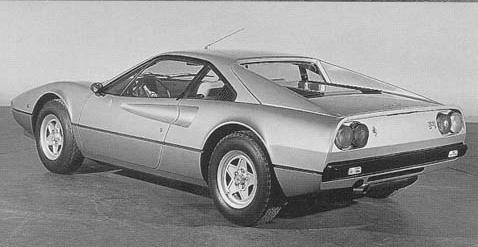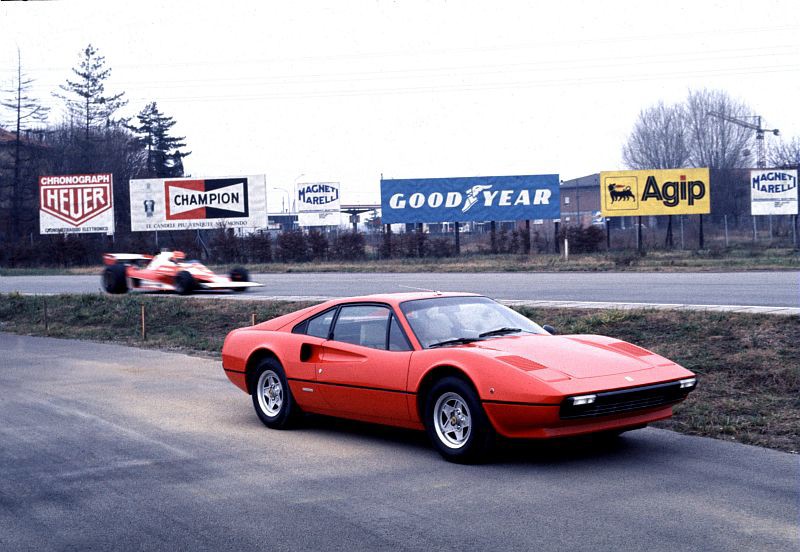
This year (2005) the 308GTB is 30 (yes THIRTY !) years old !


Copied from the Ferrari Owners web site (www.owners.ferrari.com). All copyright Ferrari Italy 2005 (c).
308 GTB – 30th Anniversary
It seems quite amazing that it is already 30 years since the 308 GTB made its
public debut, as the Pininfarina designed body has stood the test of time well,
still looking good and able to turn heads in the street, and even to people who
weren’t born when it was introduced, it is instantly recognizable as a Ferrari.
Up until the late sixties Ferrari production road cars had traditionally
featured a V12 engine, but the introduction of the Dino series with V6 engines
towards the end of the decade changed the situation. The new “small” Ferrari
attracted a new blossoming market of youthful buyers, and was a great success in
the five year production period, despite an oil crisis and increased speed
control legislation worldwide. Although there was the sister Dino 308 GT4 2+2
model with a V8 engine, it was not until the introduction of the 308 GTB in 1975
that the Dino 246 GT had a true successor.
However, perhaps a short resume of eight-cylinder Ferrari engines would not be
out of order, as it is 65 years since the genesis of a “Ferrari” with an
eight-cylinder engine, which preceded the birth of the company by seven years.
In 1940 Enzo Ferrari produced the Auto Avio Costruzioni 815 model, which was
powered by an in-line 1500cc eight-cylinder engine. This model would have
carried a Ferrari badge, had it not been for the terms of his employment
contract severance with Alfa Romeo the previous year, which forbade the
construction of a car bearing his name for a period of four years. Thus it was
not until after the end of the Second World War that he was able to build cars
bearing his name carrying the now legendary "Cavallino Rampante" logo.
For virtually the first decade of Ferrari’s existence there were four-, six- and
twelve-cylinder engines of a wide variety of capacities produced. However, it
was not until the inheritance of the works Lancia D50 Grand Prix cars midway
through the 1955 season, that there was a V8 engine in the model line-up, albeit
carrying a Lancia badge. In 1956 these cars were extensively modified, although
they were visually very similar to their predecessor, apart from now wearing a
Ferrari badge, and carried Juan-Manuel Fangio to his third consecutive World
Drivers' Championship title.
The V8 Lancia engine was further developed and used in the 801 F1 car of 1957,
whilst there were V8-engined sports racing cars like the 248 SP and the 268 SP
of 1962. In 1964 the company's armoury in F1 was the V8-engined 158 F1 model and
the flat-12 engined 512 F1, basically the same car apart from the engine
configuration. The 158 F1 took John Surtees to the Drivers’ Championship title,
and a combination of the two models Ferrari to the Constructors’ Championship in
Formula One that year.
The V8 engine then disappeared from the Ferrari line-up for almost a decade,
before the concept was resurrected on their first eight-cylinder road car, the
3-litre transverse-engined Dino 308 GT4, which appeared in 1973, and whose
engine/transmission assembly was modelled on that used in the Dino 246 GT/GTS
models.
This brings us up to the 308 GTB, which shared the same 3-litre V8
engine/transmission layout, and which was presented to the public in October
1975 at the Paris Salon. Although the body style was a then in vogue wedge
shape, there were shades of the Dino 246 in the Pininfarina design details, like
the door scallops, buttressed vertical curved rear screen and twin paired tail
light treatment. It was an instant hit both with the press and the public, and
this model and the succeeding V8 models have now formed the backbone of Ferrari
road car production for 30 years. The 308 GTB also marked a first in Ferrari
road car production as it was constructed with a fibre-glass body, although this
construction method was superseded by more traditional steel and aluminium
panels in late 1976 for USA market cars, and mid-1977 for European cars. A targa-roofed
version, called the 308 GTS, joined the GTB in late 1977, easily identifiable by
the black vinyl covered removable roof panel, and black louvred panels over the
rear quarter glass.
Less obvious, but certainly more significant, was the fact that the GTB version
(with the exception of the American 1978 model year) was equipped with the dry
sump version of the engine, whereas the GTS was a straight carry over of the 308
GT4’s wet sump power unit.
In 1980, again due to emission legislation changes, particularly in the USA, a
Bosch K-Jetronic fuel injection system replaced the quad twin-choke Weber
carburettor assembly, and this led to a reduction in the power output, as it was
still in relatively early stages of development for road car use, but by
everyday standards of the time you were still talking about a quick car. The
model names became 308 GTBi and 308 GTSi, with this badging appearing on the
tail panel, whilst subtle changes to the interior trim, the most noticeable
being the change of the instrument binnacle face from an aluminium to a satin
black finish, coincided with the change of model name.
For the Italian market a 2-litre version of the 308 series was produced from
1980, initially normally aspirated, called the 208 GTB/S, it mirrored its
3-litre peers in appearance apart from the tail badges and satin black instead
of body-colour louvres behind the headlight pods. This was superseded by a
turbocharged version in 1982, which was Ferrari's first turbocharged road car,
initially only available in closed form, it was designated the 208 GTB Turbo. In
1983 a targa roof 208 GTS Turbo variant became available.
The problem of strangled power was addressed in 1982 with the introduction of
the quattrovalvole (four valves per cylinder) models, which redressed the
balance of power in Ferrari’s favour whilst still satisfying emission
legislation. There were some small external cosmetic changes to the 308 series,
the most noticeable being a revised front grille layout with uncovered driving
lights in the extremities, the addition of a slim louvre panel across the front
lid and the “308 quattrovalvole” tail badge on both GTB and GTS. In the interior
there were subtle changes to the seat stitch pattern, which now featured cloth
centres as standard, although full leather was still available upon request, and
the steering wheel was of a new three spoke design. The concurrent 208 Turbo
models also featured the new front lid louvre, but on these models it was
painted satin black to match those behind the headlight pods. This model also
featured a satin black spoiler at the trailing edge of the roof as standard,
which was also available as an option on the 308 Quattrovalvole.
The 308 series also spawned some competition development using the model as a
base. A brutal 308 based twin-turbo model was developed by Carlo Facetti to
contest the 1980 World Endurance Championship. He called it the Carma FF 308,
and while blindingly fast, it suffered from reliability problems, and the
project was soon abandoned. More successfully, in the early eighties a series of
308 GTB models were modified by Michelotto of Padova, who have done a large
amount of small-series competition development work for Ferrari over the years,
to become rally cars. These were raced with considerable success in Italian
national rallies, and also by the French importer Charles Pozzi, whose cars
included back-to-back wins in the Tour de France Auto amongst their successes.
Whilst on the development front, perhaps mention should also be made of another
Michelotto creation, the 308 GT/M, of which just three cars were built in 1984.
In appearance it was like a scaled-down 512 BB LM, and featured a longitudinally
mounted naturally-aspirated V8 engine mated to a Hewland gearbox, whilst the
body was manufactured from composite materials. Its basic shape was to be found
later in the GTO Evoluzione, which led into the F40 in 1987.
At the 1984 Geneva Salon Ferrari stunned the motoring world when it presented
the limited production GTO, with its twin turbo longitudinally mounted 2.8 litre
V8 engine producing a claimed 400 bhp. A healthy dose of steroids gave the
basically 308 shaped body a muscular stance, with bulging fenders covering split
rim wheels, plus deep chin and tail spoilers. There were exhaust air slots in
the rear wings, striking an analogy with the front wing slots on the legendary
250 GTO of 1962. The intent of the production run had been to produce the 200
examples required to homologate the car in the group "B" competition category,
but then the governing body changed the rules, leaving Ferrari with a car that
had nowhere to race. They didn't have to worry, as the model captured their
clients’ imagination, and the production numbers stretched from the originally
proposed 200 to 272 examples. It would be fair to call this the original
supercar, as its success spawned a plethora of limited series models from other
high profile manufacturers.
The 308 series production run came to an end 20 years ago, a decade after its
introduction, in 1985, when the 328 derivatives were announced at the Frankfurt
Salon. A year later the 208s were superseded by the intercooler versions -
dropping the 208 moniker to become simply the GTB Turbo and GTS Turbo - which
adopted similar bodywork modifications to the 328s, production then ending in
1989.
The 308 GTB was an important model in the history of Ferrari, as it opened up
Ferrari ownership to a much wider range of clients, pushing production figures
to levels never previously achieved and, as previously noted, it and its
successors have been the mainstay of Ferrari production for three decades.
Production Figures
| Model | Production Period | No. Built | Chassis # Range |
| 308 GTB (Fibre-glass) | 1975 – 1977 | 808 | 18677 – 21289 |
| 308 GTB (Steel) | 1977 – 1980 | 2185 | 20805 – 34329 |
| 308 GTS | 1977 – 1980 | 3219 | 22619 – 34501 |
| 208 GTB | 1980 – 1982 | 160 | 31219 – 41329 |
| 208 GTS | 1980 – 1982 | 140 | 31249 – 41265 |
| 308 GTBi | 1980 – 1982 | 494 | 31327 – 43059 |
| 308 GTSi | 1980 – 1983 | 1743 | 31309 – 43079 |
| 308 GTB QV | 1982 – 1985 | 748 | 42809 – 59071 |
| 308 GTS QV | 1982 – 1985 | 3042 | 41701 – 59265 |
| 208 GTB Turbo | 1981 – 1985 | 437 | 41357 – 59277 |
| 208 GTS Turbo | 1982 – 1985 | 250 | 42863 – 59279 |
| 308 GTB Michelotto* | 1978 – 1985 | 15 | 08380 – 31559 |
* This series were constructed by Michelotto of Padova on chassis from within
the production series listed above, except the first which was built on a
modified 308 GT4 chassis. Therefore they should not be included in the count of
overall numbers built.

Ferrari's Fiorano test track, period photo